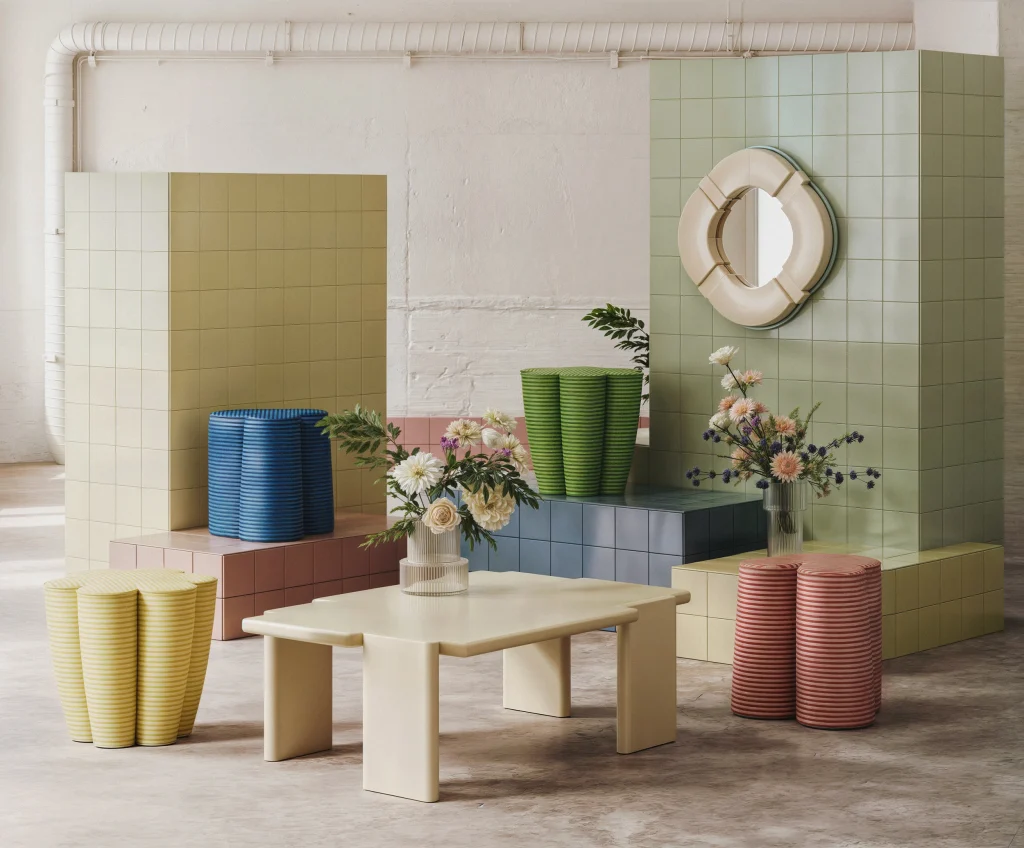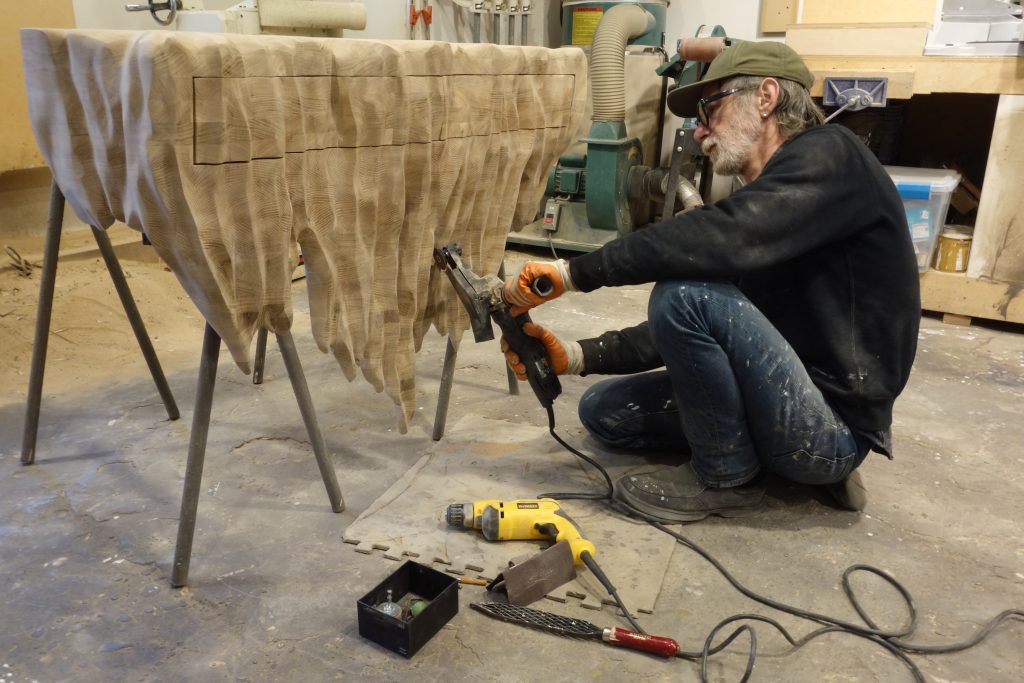Studio Plastique at Crossovers: Searching for Answers within the Plastic Arts
“As a society, we are not only disconnecting from our natural environment, we are also alienated from what we consume”
– Studio Plastique


View Studio Plastique’s Out of the Woods series presented in the Belgian Collection at Crossovers.
The Plastic Arts is a term that originally defined any physical manipulation made by humans to shape a “plastic” or mouldable medium. This term might be a bit provocative today but it has been around long before we discovered how to create literally anything object we would like (necessary or not) out of the decomposed remains of eons upon eons of our evolutionary ancestors. There’s no denying that modern industrial production and the use of petroleum for this universal material, plastic, has created a multitude of advancements (including medical) that shape living in this modern globalized society. Along with its revolutionary benefits, in this era of the climate crisis, we are currently dealing with the outcome of unchecked and arguably grossly unthoughtful material use. While recovering from this may seem impossible, moving forward in creating a more thoughtful material world will require a complete and total reevaluation of material, where the outcomes may not be so black and white.
To clearly state the evil of one material while praising the inherent good of another is definitely not the way forward, and it’s happened to us in the past. Before entering the “Plastic Age” mankind has made its run through a number of other abundant resources to create a world of homes, tools, and objects; stone, iron, and wood have shaped our material language in the past and these natural materials are seen today as a saving alternative our plastic addiction. However, we have numerous examples and warnings of times in the past when heavy reliance and the resulting disapreance of these resources have had (Easter Island anyone?). So maybe after all, regardless of how natural or artificial, the origins of our objects may be, it isn’t the be-all-end-all of deciding if it is good or bad. So what is then?
Studio Plastique is comprised of Belgian designers Archibald Godts and Theresa Bastek, founded their studio to answer and address the real, significant tough questions such as these that we face in modern society. Reimagining our object use and how the duo views their role as creators in the plastic arts can address issues anywhere from glasses and drinking vessels that won’t let you drink more alcohol once you’ve “had enough”, to how our relation to man’s four-legged best friend can help an overlooked aging population. Most recently these two revolutionary minds have begun an investigation into mankind’s urban disconnect from our ephemeral home, the forest, and how modern, thoughtful use of its resources may be one of society’s long-awaited answers.


What do you think are some of the biggest issues in society today that you would like to try and address in some of your future projects?
Our society’s current relation towards nature is an endless source for reflection. We believe as designers we can play an essential role, as we happen to be sitting on the side of the table equipped with a unique set of tools for proposing evolution.
We take great pleasure in exploring, dissecting and understanding the contexts we touch in great depth. Therefore we also try also to get the political side of our world involved and engaged in a dialogue with our researches and findings during these endeavours so they too, we hope, use their position in favour of evolution.
As designers focusing on societal issues, what is your process for material selection, and how vital is material choice when designing to address these issues?
Considering our holistic approach towards design, we always start with and end with material questions. The choice of material has not only a big impact on sourcing and production, but ultimately and especially it has an impact on people, on the final consumers and our common environment. With “Out of the Woods” for example, the role of design in relation to the world’s forests was the starting point of the exploration. Throughout cultures and time, we have been acknowledging and respecting the forest as a unique and essential source of wealth for our thriving and survival. Wood is a wonderful material provided to us by the forest, but reducing this ecosystem to a source solely for timber or the arable land freed by deforestation, results in one of the most problematic relations to nature we currently have. Taking less drastically, but more through give and take is what we propose with “Out of the Woods.” Using tree resin harvested at regular intervals combined with other residues we can harvest from the forest such as leaves, needles, but also industrial residues such as sawdust, offers a diversified vision of materials harvested from the forest. It is important in our choice for materials that such considerations are embedded within the design of any product.


In the works you are presenting at Crossovers, “Out of the Woods”, apart from addressing sustainable production methods, the works also address a disconnect between man and nature in modern society, where did you get the inspiration for these works?
Growing up in both rural and urban environments, we have learned to understand our surroundings by scrutinising the differences and reasons for certain behaviours from a variety of angles. One could say this constant curiosity leads us to dissect cycles and systems to create a better understanding. As a society we are not only disconnecting from our natural environment, we are also alienated from what we consume, how we consume and what and how we trash. It is a forced disconnection because processes increasingly escape our understanding. As designers we find it therefore very important to use our skills to instigate and inspire more understanding and mutual respect between all of us. We can all learn a lot from nature or our colleagues from other disciplines alike. Politics could use more design in their decision making, design can learn a lot from politics, industry, science and vice versa, etc. It happens more and more, we do it all the time and it is hugely inspiring.
If we are to begin re-humanising design, do you think it will be possible to achieve an ideal balance between, technology, nature and artificiality?
Ultimately design is strongest, we realised, when being a multidisciplinary approach. When all fields and their levels of understanding could and would think together more thoroughly, a more ideal balance between technology, nature and artificiality might come about. Realistically speaking however the desire for more crossovers between disciplines seems hard to find.
It could be possible to say that mass production and hyper-commodification have led to many of the issues we currently face in society, how can thoughtful design save us?
Design can propose meaningful objects that ask for a responsible consumption. Design can inform, raise questions and propose answers. It can do so with the best of intentions. But ultimately all of this should be meant for individuals that wish to be part of a common vision for their planet, their environment. We are all on the same ship. We are convinced that the ultimate project we need to deal with in almost all of our societies is education. Education should give you the relevant tools, train you in the way that suits you individually, guide one in developing into an independent and responsible individual. That is currently not the case. Design can and should be a part in shaping this education for today and tomorrow.


Crossovers by Adorno will present a range of collections of dynamic works by independent designers from a selection of local scenes. The exhibition celebrates the designers and communities playing a central role in maintaining and renewing today’s local design and crafts cultures. Studio Plastique’s work and the works presented in the Belgian Collection by Elien Hatjaens show a level of future-oriented approaches to materiality in design, focusing on natural materials vital for the preservation and renewed relevance of craft. Presenting these works together with works from 10 other top design scenes from around the world creates a cross-cultural dialogue to examine the current state and future of contemporary design.
To preview the Belgian collection and stay up to date on the release of further news & previews sign up to our newsletter below.


Bio
Plastique is a collaboration between designers Archibald Godts and Theresa Bastek. They founded the studio after their studies at the Design Academy Eindhoven.
With a common passion for cross-cultural investigations and societal topics, their practice aims to forge links between the past, the present and the future, the ratio and the heart, the material and the emotional, the real and the virtual, the human and the machine. By doing so, their work embodies the human needs among the rigid structures we are surrounded by, in a way that feels obvious or sometimes absurd.
This striving for empathic approaches in an increasingly dehumanized world, combined with the necessary rational methodology, results in environments and objects conceived for human life to bloom, as well as critical reactions on contemporary phenomena and envisions of future scenarios.











